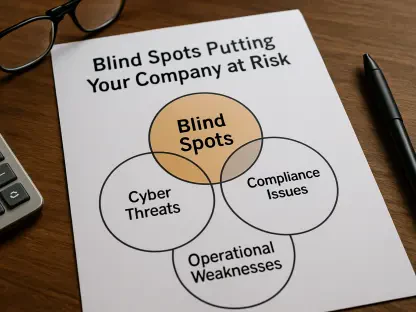In the heart of the U.S. healthcare system, a silent but deadly battle is raging against an invisible enemy—cybercriminals who are increasingly targeting hospitals, clinics, and medical providers with devastating precision. The stakes are unimaginably high as these attacks do more than disrupt digital systems; they jeopardize patient lives by delaying critical treatments and compromising sensitive data. With breaches escalating at an alarming rate, the industry finds itself at a critical crossroads, struggling to defend against sophisticated threats while maintaining the trust and safety of those who rely on it most. This pressing issue demands immediate attention, as the consequences of inaction are already manifesting in longer hospital stays, heightened complications, and even loss of life. As the digital landscape evolves, so too must the strategies to protect it, lest patients continue to bear the brunt of this escalating crisis. The following discussion delves deep into the scope of these cyberthreats, their profound impact on care delivery, and the glimmers of hope emerging through innovative defenses.
Rising Tide of Cyberattacks in Healthcare
The frequency and ferocity of cyberattacks on healthcare organizations have reached unprecedented levels, painting a stark picture of an industry under siege. Recent data indicates that a staggering 93% of healthcare entities encountered an average of 43 cyberattacks over the past 12 months, with projections suggesting an even bleaker outlook for the current year. Reports from industry watchdogs reveal over 4,000 breach incidents in just the first half of 2025, with a significant portion directly impacting the health sector. This relentless upward trend underscores how cybercriminals are capitalizing on the immense value of patient data and the critical nature of medical operations, making healthcare a prime target for ransomware, phishing, and other malicious activities. The inability to stem this tide reflects deep systemic challenges that require urgent and coordinated responses to safeguard vulnerable systems.
Beyond the sheer volume of attacks, the nature of these threats is evolving with alarming sophistication, particularly through third-party and supply chain vulnerabilities. A notable 30% surge in ransomware attacks targeting healthcare businesses and their partners has been recorded this year, with the U.S. bearing the heaviest burden. Hundreds of incidents have struck direct care providers and associated firms, such as pharmaceutical companies, leading to the compromise of millions of patient records globally. Ransom demands often reach into the hundreds of thousands of dollars, placing immense financial pressure on organizations already stretched thin. This interconnected web of dependencies means that a breach in one part of the supply chain can ripple across the entire healthcare ecosystem, amplifying the damage and complicating recovery efforts. Addressing these external vulnerabilities is now as critical as securing internal systems.
Patient Care Under Threat
The human toll of these cyberattacks is perhaps the most heartbreaking aspect of this crisis, as disruptions to clinical operations translate directly into harm for patients. A staggering 72% of affected healthcare organizations have reported interruptions to patient care this year, a slight but concerning increase from previous figures. Over half of these entities noted heightened complications during medical procedures, while more than a quarter linked these incidents to increased mortality rates—a grim statistic that highlights the life-and-death stakes involved. When systems are crippled by ransomware or other attacks, the ability to deliver timely treatment falters, leaving patients vulnerable to worsening conditions and, in the worst cases, tragic outcomes. This reality serves as a sobering reminder that cybersecurity is not just a technical issue but a fundamental component of patient safety.
Compounding the clinical fallout are specific attack types that exacerbate particular challenges in care delivery. Supply chain breaches, for instance, disrupt operations in nearly 87% of cases, often halting access to essential medical supplies or systems. Ransomware attacks contribute to extended hospital stays in two-thirds of incidents and force patient diversions in half, as facilities scramble to restore functionality. Meanwhile, business email compromise schemes frequently delay critical procedures, with 65% of such attacks causing significant setbacks. These varied impacts illustrate how each cyberthreat carries unique risks to healthcare delivery, creating a complex web of challenges that providers must navigate under immense pressure. Protecting patients now demands not only robust digital defenses but also contingency plans to maintain care continuity during crises.
Financial Burden of Cyber Breaches
The financial ramifications of cyberattacks on healthcare organizations are staggering, creating a dual challenge of recovery costs and constrained budgets. Although the average cost of a major cyber incident has dipped slightly to $3.9 million this year, the burden remains crushing for many institutions. More troubling is the rise in ransomware payments, with the average payout climbing to $1.2 million as roughly a third of victims succumb to demands in a desperate bid to regain access to critical systems. These escalating ransoms reflect the growing audacity of attackers who know that healthcare providers, often operating on thin margins, cannot afford prolonged downtime. The financial strain diverts resources from patient care improvements to crisis management, perpetuating a cycle of vulnerability that cybercriminals exploit with ruthless efficiency.
Beyond direct costs, the indirect financial impact of these breaches further tightens the noose around healthcare budgets. Recovery efforts often involve extensive system overhauls, legal fees, and regulatory fines, not to mention the loss of patient trust that can drive business elsewhere. The need to invest in stronger cybersecurity measures competes with other pressing priorities, such as hiring staff or upgrading medical equipment, creating tough choices for administrators. As ransom demands continue to rise, the temptation to pay becomes harder to resist, even though doing so often emboldens attackers to strike again. Breaking this cycle requires a strategic shift toward prevention rather than reaction, with investments in security infrastructure that can withstand the evolving tactics of cybercriminals and preserve fiscal stability for the long term.
Systemic Weaknesses and Human Factors
At the core of many cybersecurity failures in healthcare lie persistent vulnerabilities in clinical infrastructure that attackers exploit with alarming ease. Systems like Citrix NetScaler, crucial for managing access to electronic health records, have become frequent targets, alongside exposed databases and remote access tools that offer backdoors into sensitive environments. Recent alerts about flaws in Cisco Adaptive Security Appliances further compound these risks, allowing unauthorized access past traditional firewalls. Such weaknesses in widely used technologies create systemic points of failure that jeopardize not only data security but also the continuity of critical medical operations. Addressing these gaps demands rigorous vulnerability management and a proactive approach to patching and updating systems before they can be weaponized by malicious actors.
Equally troubling is the role of human error as a primary driver of cybersecurity incidents within healthcare settings. A staggering 96% of organizations have experienced multiple instances of data loss due to insider risks over recent years, with employee negligence often at the root. Common missteps include failing to adhere to security policies or inadvertently sending sensitive information to the wrong recipient, errors that account for a significant portion of breaches. Over half of these incidents disrupt patient care, with many contributing to severe outcomes like increased mortality. This persistent human factor underscores the urgent need for comprehensive training programs and stricter protocols to minimize mistakes. Cultivating a culture of cybersecurity awareness is no longer optional but essential to fortifying defenses against both internal and external threats.
Innovative Defenses on the Horizon
Amid the mounting challenges, there are encouraging signs of progress in how healthcare organizations are leveraging technology to combat cyberthreats. More than half of surveyed entities have integrated artificial intelligence into their cybersecurity frameworks, with a majority reporting significant improvements in threat detection and prevention. AI’s ability to analyze vast amounts of data in real time offers a powerful tool for identifying anomalies and preempting attacks, potentially offsetting the limitations of constrained security budgets. However, the adoption of such advanced solutions is not without hurdles, as gaps in expertise and leadership often impede full implementation. Overcoming these barriers is critical to ensuring that technological advancements translate into tangible protections for patient data and clinical operations.
Collaboration also emerges as a vital lifeline in the fight against healthcare cybercrime, with initiatives like threat-sharing providing a collective defense mechanism. Organizations such as Health-ISAC play a pivotal role by disseminating timely alerts about emerging vulnerabilities and attack patterns, enabling members to fortify their systems proactively. This shared intelligence approach helps level the playing field against sophisticated threat actors who thrive on exploiting isolated targets. Yet, the effectiveness of these efforts hinges on widespread participation and the willingness to prioritize cybersecurity at the highest levels of leadership. Building on these collaborative foundations, alongside technological innovation, offers a pathway to resilience that the healthcare sector desperately needs to safeguard its most vulnerable stakeholders.
Adapting to a Shifting Threat Landscape
The adversaries behind healthcare cyberattacks are not standing still, as groups like SafePay and Qilin demonstrate a chilling adaptability in their tactics. These threat actors have ramped up their operations this year, targeting both direct providers and interconnected third-party partners to maximize disruption. Their strategies often involve stealing massive volumes of data—sometimes terabytes in a single breach—while demanding ever-higher ransoms to release control of critical systems. This dual approach of extortion and data theft amplifies the damage, as compromised information can be sold on dark markets or used for further attacks. Staying ahead of such evolving threats requires healthcare organizations to invest in robust endpoint security and continuously monitor for signs of infiltration across their networks.
Equally important is understanding the strategic focus of these cybercriminals, who increasingly exploit the interconnected nature of healthcare supply chains. By targeting vendors and business associates, attackers gain access to a broader ecosystem, often bypassing the defenses of primary providers. This trend highlights the need for comprehensive risk assessments that extend beyond internal systems to include every link in the operational chain. Strengthening third-party security protocols and enforcing stringent vendor compliance are essential steps to mitigate these cascading risks. As threat actors refine their methods, the healthcare industry must respond with equal agility, adopting a dynamic defense posture that anticipates rather than reacts to the next wave of attacks.
Building a Resilient Future
Reflecting on the relentless wave of cyberattacks that battered the U.S. healthcare sector, it became evident that the industry stood at a pivotal moment where lives hung in the balance. The profound disruptions to patient care, coupled with crushing financial losses, painted a sobering picture of vulnerability that demanded urgent action. Yet, amid the challenges, there was a foundation of innovation and collaboration that offered a beacon of hope for those navigating this crisis. The integration of artificial intelligence and shared threat intelligence had already shown promise in bolstering defenses against sophisticated adversaries. Moving forward, the focus must shift to closing gaps in expertise, enhancing employee training, and fortifying infrastructure to prevent future breaches. By prioritizing these actionable steps, alongside sustained investment in cybersecurity, healthcare organizations can build a resilient framework that protects patients and preserves trust in an increasingly digital world.









